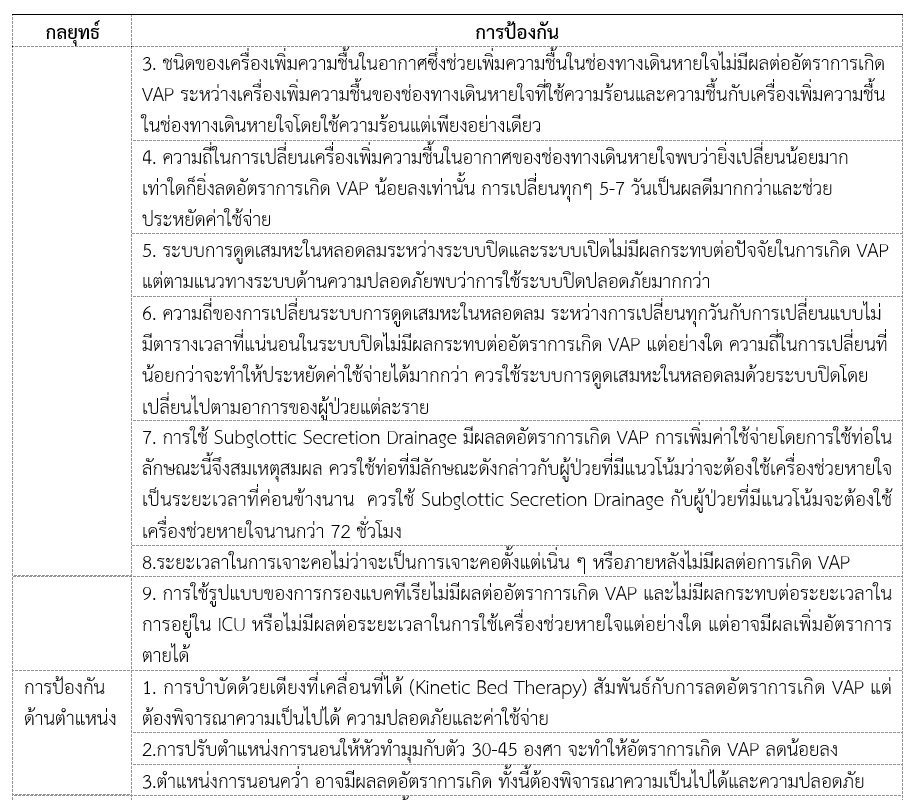แนวทางป้องกันปอดอักเสบในผู้ป่วยที่ใช้เครื่องช่วยหายใจ (VAP): การทบทวนเนื้อหาจากงานวิจัย
คำสำคัญ:
ปอดอักเสบ, เครื่องช่วยหายใจ, แนวปฏิบัติบทคัดย่อ
บทความวิชาการนี้เพื่อทบทวนงานวิจัยให้ได้แนวทางป้องกันปอดอักเสบในผู้ป่วยใช้เครื่องช่วยหายใจที่เป็นปัจจุบัน วิเคราะห์และสังเคราะห์เนื้อหาจากหลักฐานที่ตีพิมพ์ ค.ศ. 2009-2019 ประเมินคุณภาพตามเกณฑ์เมลนิคและไฟน์เอาท์-โอเวอร์ฮอลท์และโพลิทและฮังเกลอร์ พบหลักฐานระดับ 1 จำนวน 7 เรื่อง ระดับ 2 จำนวน 14 เรื่อง ระดับ 4 จำนวน 1 เรื่องและระดับ 5 จำนวน 1 เรื่อง แนวทางที่ได้แบ่งตามหลักการป้องกันประกอบด้วย 1) การลดโอกาสเสี่ยงปอดอักเสบ 2) การลด Micro-Aspiration ทางท่อช่วยหายใจ 3) การควบคุมการติดเชื้อ 4) การป้องกันการขยายตัวของแบคทีเรียและ 5) การจัดการเครื่องช่วยหายใจ กำหนดเป็นกลยุทธ์ป้องกันได้ 3 ด้าน คือ ด้านกายภาพ (การสอดท่อช่วยหายใจทางปาก ความถี่การเปลี่ยนอุปกรณ์ ชนิดและความถี่การเปลี่ยนเครื่องเพิ่มความชื้นในอากาศ ระบบดูดเสมหะ ความถี่การเปลี่ยนระบบดูดเสมหะในหลอดลม การระบายเสมหะทาง Subglottic ระยะเวลาที่เจาะคอ รูปแบบการกรองแบคทีเรีย) ด้านตำแหน่ง (การบำบัดด้วยเตียงเคลื่อนที่ การปรับตำแหน่งการนอน การนอนคว่ำ) และด้านเภสัชวิทยา (การใช้ยาปฏิชีวนะ การปนเปื้อนทางช่องปาก การป้องกันไซนัสอักเสบ) การทบทวนงานวิจัยทำให้ได้ข้อมูลสู่แนวปฏิบัติด้านการป้องกันที่มีประสิทธิภาพ เป็นปัจจุบันและให้การพยาบาลในแนวทางเดียวกัน ช่วยลดช่องว่างของนโยบาย เพิ่มการปฏิบัติที่ดีบนบริบทการปฏิบัติงานจริงและให้ความสำคัญกับผู้ใช้บริการเป็นศูนย์กลางการดูแล
เอกสารอ้างอิง
Bamrasnaradura Infectious Diseases Institute. (2015). Guidelines for Preventing Pneumonia from Using a Ventilator. Bangkok: Printing Office of the National Buddhism Office. (in Thai)
Bloos, F., Muller, S., Harz, A., Gugel, M., Geil, D., Egerland, K., et al. (2009). Effects of Staff Training on the Care of Mechanically Ventilated Patients: a Prospective Cohort Study. Br J Anaesth. 103, 232–237.
Chaiyawong, A., Kasettath, M., Naku, A. & Jesanti S. (2019). Development of Clinical Nursing Practice Guideline for Preventing Ventilator Associated Pneumonia in Intensive Care Unit, Lamphun Hospital. Lanna Public Health Journal, 10(3), 183-193. (in Thai)
De Smet, A. M., Kluytmans, J. A., Cooper, B. S., Mascini, E. M., Benus, R. F., van der Werf, T.S., et al. (2009). Decontamination of the Digestive Tract and Oropharynx in ICU Patients. N Engl J Med, 360, 20-31.
Dudeck, M. A., Horan, T. C., Peterson, K. D., Allen-Bridson, K., Morrell, G., Anttila, A., et al. (2011). National Healthcare Safety Network (NHSN) Report, Data Summary for 2011, Device-associated Module 2013. [updated October 31st, 2013].
Hamilton, V. A., Grap, M. J. (2012). The Role of the Endotracheal Tube Cuff in Microaspiration. Heart Lung J Crit Care, 41, 167-172.
Han, J. & Liu, Y. (2010). Effect of Ventilator Circuit Changes on Ventilator Associated Pneumonia: a Systematic Review and Meta-Analysis. Respir Care, 55, 467-474.
Hass, C. F., Eakin, R. M., Konkle, M. A. & Blank, R. (2014). Endotracheal Tubes: Old and New. Respiratory Care, 59(6), 933-955.
Hess, D. R. (2005). Noninvasive Positive-Pressure Ventilation and Ventilator-Associated Pneumonia. Respir Care, 50, 924-929.
Kalanuria, A. A., Zai, W., & Mirski, M. (2014). Ventilator-Associated Pneumonia in the ICU. Crit Care, 18(2), 208.
Kelly, M., Gillies, D., Todd, D. A. & Lockwood, C. (2010). Heated Humidification Versus Heat and Moisture Exchangers for Ventilated Adults and Children. Anesth Analg, 111, 1072.
Keyt, H., Faverio, P. & Restrepo, M. I. (2014). Prevention of Ventilator-Associated Pneumonia in the Intensive Care Unit: A Review of the Clinically Relevant Recent Advancements. Indian J Med Res, 139(6), 814-821.
Kredo, T., Bernhardsson, S., Machingaidze, S., Young, T., Louw, Q., Ochodo, E., et al. (2016). Guide to Clinical Practice Guidelines: The Current State of Play. Int J Qual Ealth Care, 28(1), 122-128.
Lambeau, S. O., Van de Vyver, K., Brusselaers, N., Vogelaers, D. & Blot S. l. (2011). Prevention of Ventilator-Associated Pneumonia with Oral Antiseptics: A Systematic Review and Meta Analysis. Lancet Infect Dis, 845-854.
Melnyk, B. M. & Fineout-Overholt, E. (2005). Evidence-Based Practice in Nursing & Healthcare: a Guide to Best Practice. Philadelphia: Lippincott Williams and Wilkins.
Melsen, W. G., Rovers, M. M., Groenwold, R. H., Bergmans, D. C, Camus, C., Bauer, T. T., et al. (2013). Attributable Mortality of Ventilator-Associated Pneumonia: A Meta-Analysis of Individual Patient Data from Randomized Prevention Studies. Lancet infect Dis, 665-671.
Muscedere, J., Dodek, P., Keenan, S., Fowler, R., Cook, D. & Heyland, D. (2008). Comprehensive Evidence-Based Clinical Practice Guideline for Ventilator-Associated Pneumonia: Prevention. Journal of critical care, 23, 126-137.
Ostdijk, E. A., de Smet, A. M., Blok, H. E., Thieme Groen, E. S., van Asselt, G. J., Benus, R. F., et al. (2010). Ecological Effects of Selective Decontamination on Resistant Gram-Negative Bacterial Colonization. Am J Respir Crit Care Med, 181, 452-457.
Polit, D. F. & Hungler, B. P. (2013). Essential of Nursing Research: Method, Appraisal, and Utilization. (8th ed.). Philadelphia: Wolters Kluwer/Lippincott Williams and Wilkins.
Quenot, J. P., Ladoire, S., Devoucoux, F., Doise, J. M., Cailliod, R., Cunin, N., et al. (2007). Effect of a Nurse-Implemented Sedation Protocol on the Incidence of Ventilator-Associated Pneumonia. Crit Care Med, 35, 2031-2036.
Rawal, G., Kumar, R., Yadav, S., & Sujana, R. (2018). Ventilator-Associated Pneumonia (VAP): Overview and Preventive Strategies. British Journal of Pharmaceutical and Medical Research, 3(02), 891-896.
Robinson, B. R., Mueller, E. W., Henson, K., Branson, R. D., Barsoum, S., Tsuei, B. J. (2008). An Analgesia-Delirium-Sedation Protocol for Critically Ill Trauma Patients Reduces Ventilator Days and Hospital Length of Stay. J Trauma, 65, 517-26.
Ross, S. M. & Morrison, G. R. (2003). Experimental Research Methods. Retrieved July 3, 2019 from https://www.researchgate.net/publication/201382131_Experimental_Research_Methods.
Sebastian, M. R., Lodha, R., Kapil, A. & Kabra, S. K. (2012). Oral Mucosal Decontamination with Chlorhexidine for the Prevention of Ventilator Associated Pneumonia in Children-a Randomized, Controlled Trial. Pediatr Crit Care Med, 13, e305-e310.
Sornsomnuk, S., Khuwatsamrit, K. & Monkong, S. (2011). Effects of Using Nursing Practice Guidelines for Ventilator Associated Pneumonia Prevention on the Incidence of Ventilator Associated Pneumonia. Rama Nurs J, 23(3), 284-297. (in Thai)
Terragni, P. P., Antonelli, M., Fumagalli, R., Faggiano, C., Berardino, M., Pallavicini, F. B., et al. (2010). Early vs Late Tracheotomy for Prevention of Pneumonia in Mechanically Ventilated adult ICU Patients: A Randomized Controlled Trial. JAMA, 303, 1483-1489.
Unahalekhaka, A., Jongsuwiwatwong, W., Jamulitrat, S. & Ovretveit, J. (2017). Impact of Collaborative Quality Improvement Project on Incidence and Mortality of Ventilator-Associated Pneumonia in 18 Hospitals in Thailand. American Journal of Infection Control, 35(5), E147-E148. (in Thai)
Wang, F., Bo, L., Tang, L., Lou, J., Wu, Y., Chen, F., et al. (2012). Subglottic Secretion Drainage for Preventing Ventilator-Associated Pneumonia: an Updated Meta-Analysis of Randomized Controlled Trials. J Trauma Acute Care Surg, 72, 1276-1285.
Watcharanat, P., Namvongprom, A. & Pakdevong, N. (2015). The Effectiveness of Nursing Care Protocol on Ventilator Associated - Pneumonia in Patients with Mechanical Ventilator. Kuakarun Journal of Nursing, 22(1), 144-155.

ดาวน์โหลด
เผยแพร่แล้ว
ฉบับ
ประเภทบทความ
สัญญาอนุญาต
ลิขสิทธิ์ (c) 2022 วารสารเครือข่ายวิทยาลัยพยาบาลและการสาธารณสุขภาคใต้

อนุญาตภายใต้เงื่อนไข Creative Commons Attribution-NonCommercial-NoDerivatives 4.0 International License.
1. บทความหรือข้อคิดเห็นใด ๆ ที่ปรากฏในวารสารเครือข่าย วิทยาลัยพยาบาลและการสาธารณสุขภาคใต้ ที่เป็นวรรณกรรมของผู้เขียน บรรณาธิการหรือเครือข่ายวิทยาลัยพยาบาลและวิทยาลัยการสาธารณสุขภาคใต้ ไม่จำเป็นต้องเห็นด้วย
2. บทความที่ได้รับการตีพิมพ์ถือเป็นลิขสิทธิ์ของ วารสารเครือข่ายวิทยาลัยพยาบาลและการสาธารณสุขภาคใต้







